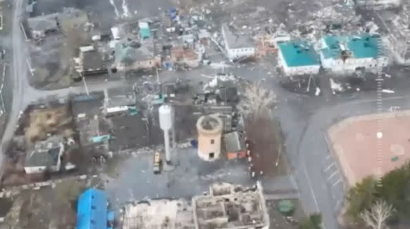Ukrainian forces have suffered a severe blow in the ongoing conflict, facing a near-total collapse as they are driven out of Russia’s Kursk region. The sudden retreat follows a period of intense fighting marked by relentless Russian attacks using aircraft, artillery, and drones.
Ukrainian Forces in Disarray
Ukrainian troops, overwhelmed and lacking vital intelligence support, have been pushed back, with reports of heavy casualties and destroyed equipment surfacing on social media. The sight of burned-out armored vehicles and fleeing soldiers has sent shockwaves through Kyiv, raising serious concerns about the country’s ability to sustain its defense.
The loss of Kursk is particularly significant as it was the only piece of Russian territory under Ukrainian control. For months, Ukrainian forces had hoped to leverage this position in future negotiations. However, the strategic setback has now made that possibility unlikely. The sudden Russian counteroffensive, combined with a breakdown in intelligence sharing between Washington and Kyiv, has left Ukrainian forces exposed. Reports suggest that the United States’ suspension of military and satellite intelligence aid played a crucial role in the recent defeats, leaving Ukrainian units unable to predict or counter Russian advances.
Russian Forces Take Control
Russia’s military launched a large-scale assault last week, targeting key supply routes and command centers in the Kursk region. Elite Russian troops, supported by North Korean military personnel, executed a well-coordinated attack that effectively cut off the M23 road, the primary supply route sustaining Ukrainian forces in the area. Ukrainian soldiers on the ground were left vulnerable to Russian strikes, with some reporting precision attacks on their positions, fueling speculation about possible intelligence leaks or advanced surveillance by Moscow.
The town of Sudzha, located at the heart of the contested territory, has reportedly fallen back into Russian control. Social media footage shows Russian forces raising their flag over the town while Ukrainian forces withdraw under fire. Kyiv’s response has been fierce, with artillery and rocket barrages aimed at slowing down the Russian advance. However, these counterstrikes have left much of the town in ruins, further complicating the situation for Ukrainian forces.
Captured Ukrainian military hardware, including American-made Abrams tanks and Bradley fighting vehicles, has been showcased by Russian troops, underlining the scale of Ukraine’s losses. The battlefield setbacks have deepened concerns in Kyiv about whether Washington’s restrictions on intelligence sharing were a factor in the rapid Russian gains. Ukrainian officials argue that without real-time satellite data and reconnaissance support, their forces were unable to predict or prepare for the enemy’s movements, leading to devastating consequences.
Ceasefire Agreement in Motion
Amid the crisis, Ukrainian leadership has proposed a ceasefire as a temporary measure to regain access to U.S. intelligence. The agreement is seen as a tactical necessity, with officials admitting that without American satellite data and surveillance, their ability to coordinate defense operations in Kursk and other contested regions is severely hindered. The ceasefire proposal is intended to restore communications with Washington and regain access to vital intelligence that could help stabilize the frontline, particularly in Kursk, where Ukrainian forces have suffered significant setbacks.
The situation has sparked widespread debate within Ukraine. Some military commanders, recognizing the dire conditions on the battlefield, cautiously support the ceasefire, seeing it as a necessary step to prevent further losses in Kursk and beyond. Others, however, fear that the move signals weakness and could embolden Russian forces to push further into Ukrainian territory. Meanwhile, in Moscow, there has been no immediate response to the ceasefire offer, leaving the situation uncertain.
Adding to the tensions, there are growing concerns in Kyiv over the accuracy of Russian air and artillery strikes, which have consistently targeted Ukrainian military bases and command centers with precision. Some Ukrainian officials suspect that Moscow has gained access to high-level intelligence, leading to speculation about possible backchannel cooperation between Russia and Washington. While there is no concrete evidence to support this theory, the timing of the intelligence blackout and Russia’s recent military successes—especially in Kursk—have fueled deep distrust toward the United States.
As the dust settles over the Kursk region, the focus now shifts to whether the ceasefire agreement will hold and whether Ukraine will be able to restore its intelligence-sharing relationship with the U.S. For now, the losses suffered in Kursk mark a devastating chapter in Ukraine’s struggle, underscoring the critical role of intelligence in modern warfare and the fragile nature of international alliances.

